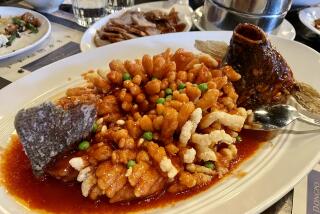Asian Pear Varieties
- Share via
Most Important Varieties
*Hosui (“abundant juice”). Large round russet pear, very tender, sweet and aromatic when ripe. Introduced in Japan in 1972, from a cross made in 1954. Now the leading variety in California; considered the best for its elegant flavor. Overripe specimens develop a rummy taste. Early-mid season.
*Nijisseiki (more correctly, nijusseiki; “20th century”). Classic round, light-skinned pear. Seedling introduced in Japan in 1898; revolutionized the pear industry. The standard of flavor, with crisp, juicy flesh and very little grittiness, but small. For many years the top U.S. variety. Ripe when pale green skin is partly tinged with yellow. Mid-season.
*Shinseiki (“new century”). Cross of 20th century and Chojuro, introduced 1945. Popular early variety. Medium size, very firm, some rock-hard, crunchy like an apple. Texture coarse, flavor mild. Skin smooth, bright yellow when ripe; avoid greenish specimens. Lumpy bottom indicates poor quality. Early.
*Ya Li (“duck pear”). The most famous Chinese pear, from a different species than Japanese varieties. Matures from green to yellow-green, but sometimes difficult to tell if ripe. Not round but pyriform or “pear-shaped,” with long stem. Has smooth, slightly waxy skin, fine crisp white flesh and a mild sweet-tart taste that sometimes verges on musty. Late.
*
Historical Varieties (not commercially important)
*Chojuro (“plentiful”). The first improved Japanese russet pear. Introduced 1895; sweet and disease-resistant. Once one of top two varieties in California, with Nijisseiki, but drier than new selections and rarely planted today. Mid-season; Orange-brown when ripe. Distinctive aroma, flavor improves in storage.
*Okusankichi (“madame luck”). Traditional Japanese variety from mid-19th century. Very large oval or turban-shaped russet pear. Specialty of Placer County Nisei growers, fading from commerce. Ripens in October. Very firm, crisp, slightly coarse flesh with sweet-tart flavor. At harvest only fair, improves in storage.
*
Other Varieties
*Ichiban Nashi (“first pear”). The earliest Asian pear to ripen, in late June. Light gold russet skin, sweet; keeps poorly.
*Kikusui (“floating chrysanthemum,” the crest of the Japanese royal family). Yellow-green skin. Same excellent flavor as 20th century, but flesh coarser and and larger. Mother of many new varieties.
*Kosui (“juice of good fortune”). Skin golden-brown on a pale green to yellow background. Very sweet, juicy and delicious. Early.
*Lai Yang (“radish shape”). Chinese pear brought to America by Lincoln Chan, a big Bartlett grower in the Sacramento Delta. Late.
*Niitaka (“new quantity”). Large, firm, orange-brown russet pear. Flesh somewhat coarse; flavor average; losing popularity. Late season.
*Seigyoku (“sapphire”). Hybrid of 20th Century and Chojuro. Round, with smooth, light greenish-yellow skin. Average quality. Early-mid season.
*Seuri (Japanese spelling; perhaps Chinese se li, “red pear”). Round Chinese pear; has yellow under-color with some russet mottling. Delicious but unattractive. Trees used as pollinizers. Late.
*Shinko (“new success”). Popular russet variety with full-bodied, nutty flavor. Resistant to fire blight; stores well. Mid-late season.
*Shinsui (“new juice”). Early russet variety. Looks and eats like Hosui, though a bit grittier and not as large. Delicate, bruises easily.
*Yoinashi (“good pear”). Newer variety. Large, with brown-buff skin. Flesh is off-white, tender, crisp and juicy. Flavor good. Mid-season.
More to Read
Eat your way across L.A.
Get our weekly Tasting Notes newsletter for reviews, news and more.
You may occasionally receive promotional content from the Los Angeles Times.










